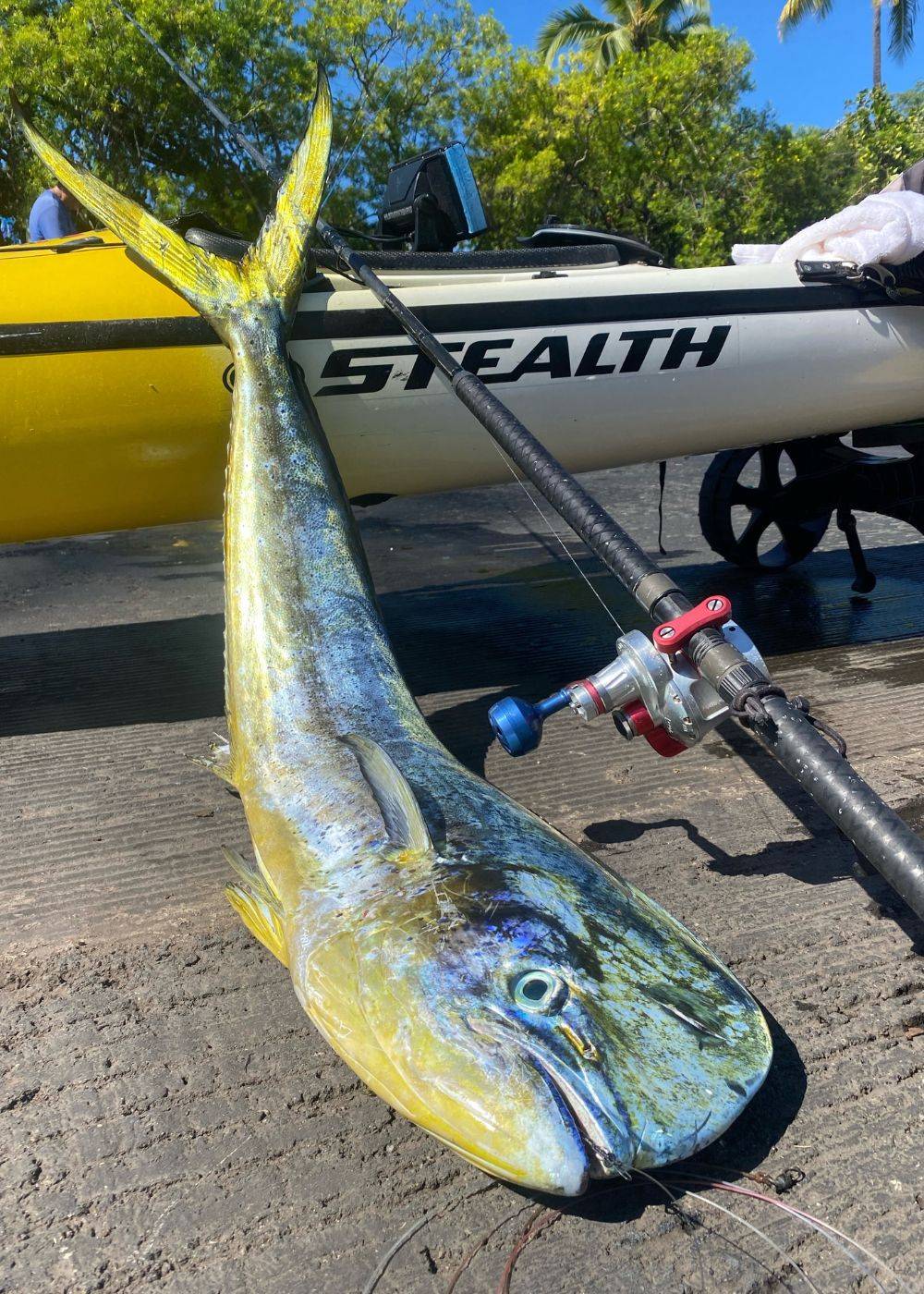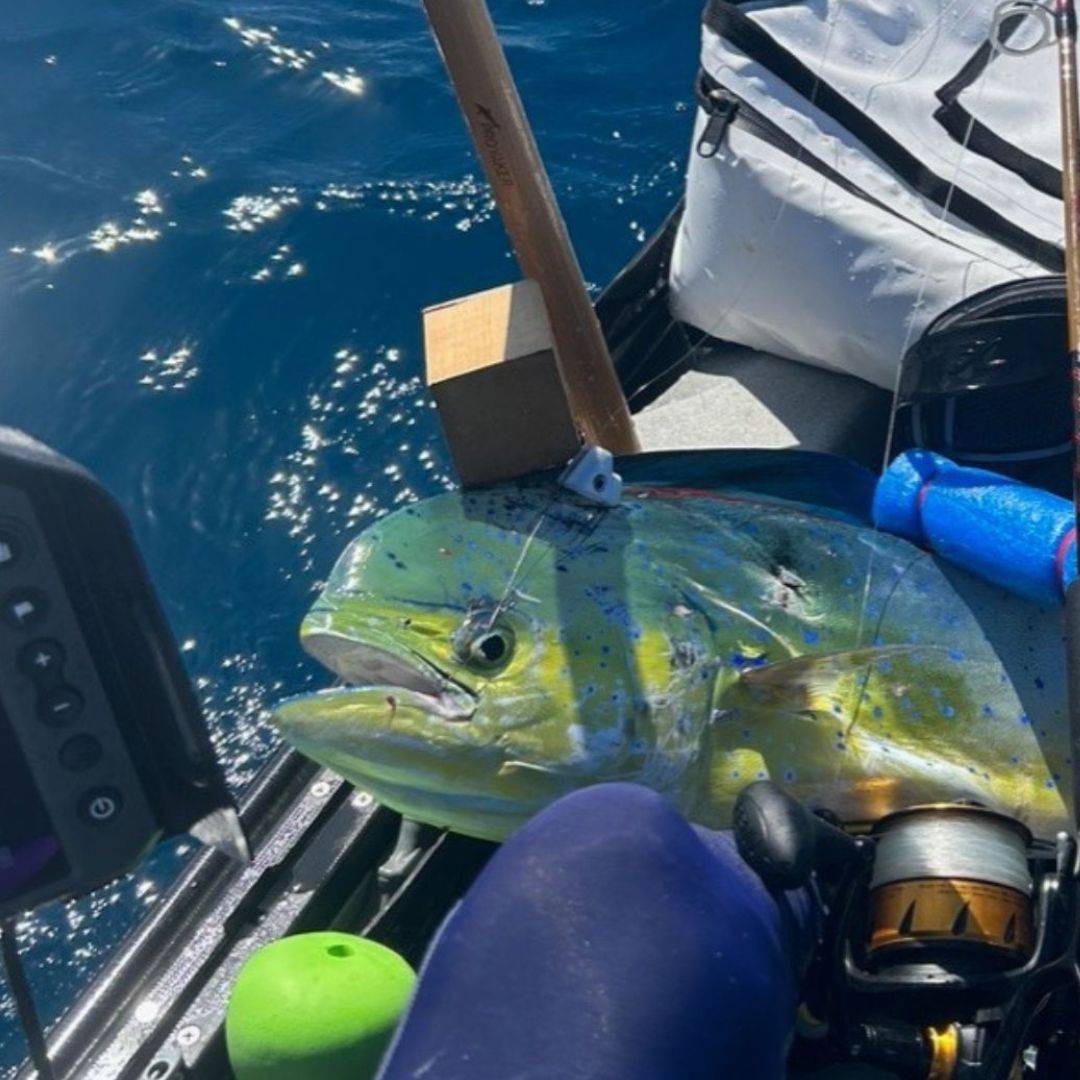Your Cart is Empty

Are you looking for a new adventure in your offshore angling? Consider offshore kayak trolling for big game fish like king mackerel, mahi, wahoo, and even marlin. Whether you’re an experienced kayak fisherman or just contemplating the idea, this article will equip you with the knowledge and techniques needed to master the art of catching these species from a kayak.
Offshore trolling from a kayak opens up a world of possibilities for adventurous anglers. Imagine paddling out into the open waters, feeling the thrill of the chase as you target these powerful game fish. With the right strategies and gear, you can turn your kayak into a fishing machine.
In this guide, we'll cover everything you need to know - from selecting the best kayak and equipment to mastering trolling techniques.
So, grab your paddle and get ready for an exhilarating fishing experience. Our ultimate guide to offshore kayak trolling will transform you into a skilled angler capable of hooking and landing those trophy fish. Let's dive into the journey to becoming a master of offshore kayak trolling.
Topics discussed:
CHOOSING THE RIGHT EQUIPMENT FOR OFFSHORE KAYAK FISHING
BEST TACTICS FOR KAYAK FISHING OFFSHORE
LOCATING HOTSPOTS FOR OFFSHORE KAYAK TROLLING
To ensure a successful offshore kayak trolling expedition, it's crucial to have the right gear. Here are the essential items you'll need to equip yourself with:
Kayak: When choosing a kayak for offshore trolling, opt for a sit-on-top model that offers stability and ample storage space. Look for a kayak with a weight capacity that suits your needs and consider features like rod holders, a comfortable seat, and a rudder or skeg for better maneuverability.
If you are going to get serious about kayak fishing, consider a pedal kayak. Options include a propeller style propulsion system as well as fin propulsion system. The ease of reverse pedaling and reliability of the propeller style system makes a good choice. Do your research. New models are coming out all the time with continual improvements.
Paddle: Even if you are not paddling, invest in a high-quality paddle that is lightweight, durable, and comfortable to grip. Consider a paddle with adjustable length options for different conditions and easier storage when not needed.
Fishing Rods and Reels: Select a fishing rod and reel combination suitable for offshore trolling. Look for a medium to action rod with a fast tip for increased sensitivity. Pair it with a high-quality reel. My recommendation is a good spinning reel with a smooth drag system and a high line capacity.
Fishing Rods and Reels: Select a fishing rod and reel combination suitable for offshore trolling. Look for a medium to action rod with a fast tip for increased sensitivity. Pair it with a high-quality reel. My recommendation is a good spinning reel with a smooth drag system and a high line capacity.
Fishing Line: Pay attention to your line selection. This is a key to success. Opt for a braided line with a monofilament top shot in the 40-50 lb test range to maximize line capacity. Use an FG or double uni-knot to tie the top shot to the main line.
Leader: Use a monofilament or even a fluorocarbon leader in most fishing situations. Select a wire leader for king mackerel and wahoo. 7-strand fishing wire is a good choice for its flexibility and resistance to kinking.

Resist the temptation to tie directly to a monofilament top shot. Instead include a quality ball bearing swivel between the top shot and leader to prevent line twists. Use a uni-knot at the swivel for monofilament and a figure 8 knot for 7-strand fishing wire.
Remember to pack additional essentials such as a tackle box, pliers, a landing net or gaff, sunscreen, a hat, and plenty of water and snacks. Being well-prepared with the right gear will significantly enhance your offshore kayak trolling experience.
Now that you're familiar with the essential equipment, let's dive into some trolling tactics for different types of big game fish.
Trolling artificial lures:Carefully selected artificial lures can be successfully trolled at slower kayak speeds. Opt for feather and skirted lures that have a good action when trolled at slow speeds.
Live bait trolling:Trolling live bait can be very effective for kayak fishermen for many different species. Select baitfish native to the area.
Troll two rods and keep the kayak moving forward at a speed that keeps the lines from tangling.
The challenge with live bait when fishing from a kayak is having ready access to fresh lively baits. One option is to use a Sabiki style rig to catch live bait as needed especially when fishing around structure.

Trolling natural baits:Trolling natural baits including ballyhoo, cigar minnows, squid, and strip baits are a top choice for offshore trolling from a kayak. Proper rigging provides a natural swimming action to natural baits. The scent and appearance of natural baits add to the likelihood of enticing a strike from wary game fish.
Pin-rigs are traditionally used with ballyhoo. TrollTrue lures and rigging offer a fast and easy way to rig ballyhoo. They can also be used with cigar minnows. Without the lure, the rigging can also used for live bait.
Regardless of the type of bait, remember a couple of other tactics specific to offshore kayak trolling.
Experiment: Vary the speed and the distance behind the kayak to troll at different depths. Find what works on each particular day.
Clear the line: There is always a lot of excitement and activity every time a fish is hooked. Make a habit to always clear the second line before fighting a hooked fish. Not doing so will almost always come back to haunt you.
If you are looking to get a sense of what offshore kayak fishing is really like, check out 30 Miles Out. I'm not affiliated with him at all, but he has some great offshore kayak fishing content. The link is to one of his YouTube playlists.

Your range in a kayak will be limited so it is very important to carefully consider where you launch. Here are some tips to help you locate hotspots where big game fish are likely to be found.
Study charts and maps: Nautical charts and fishing maps are valuable resources that can help you identify underwater structures, drop-offs, and other features where game fish may congregate. Look for areas with significant depth changes, wrecks, or reefs that create ideal conditions for fish.
Talk to local anglers or bait shop employees: Local knowledge is invaluable when it comes to finding productive fishing spots. They can provide valuable insights into seasonal patterns and the best locations for specific species.
While you’re on the water, be attentive to your surroundings.
Follow the birds: Seabirds, such as seagulls or pelicans, are excellent indicators of fish activity. They often hover above schools of baitfish, which in turn attract big game fish. If you spot a group of birds diving into the water, it's a good sign that fish are feeding below.
Look for floating debris, tide lines, or weed line. Concentrate on these areas if you find them.
Remember, locating hotspots may require some trial and error. It's essential to stay patient, persistent, and open to learning from each fishing trip.
When it comes to offshore kayak trolling, safety should always be your top priority. As you venture further from the shore, you need to be prepared for any situation that may arise. Here are some essential safety tips to keep in mind before you embark on your offshore kayak trolling adventure.
Choose a PFD that is Coast Guard approved and specifically designed for kayaking. Ensure it fits snugly and has pockets to store small essentials. Manually or automatically inflated PFDs are a good choice for added comfort.
Most importantly, always wear your PFD. Even if you consider yourself a strong swimmer, unexpected circumstances can occur, and having a PFD on will provide you with an extra layer of protection.
Buddy system: Whenever possible, fish with at least one other partner.
Check the weather conditions before heading out. Offshore waters can be unpredictable, and it's crucial to be aware of any changes that may affect your safety. High winds, rough seas, or storms can make kayaking dangerous, so it's best to postpone your trip if conditions are unfavorable.
Invest in a reliable communication device. While out on the water, it's essential to have a way to reach out for help if needed. A waterproof and floatable handheld VHF radio or a personal locator beacon (PLB) can be lifesaving in emergencies.
Let someone know about your plans. Before you head out, inform a friend or family member about your intended route, estimated time of return, and any emergency contact information. This way, if something goes wrong, help can be notified promptly.
Game fish are large and powerful fish. King mackerel and wahoo have razor sharp teeth. Combine all that in the close quarters of a kayak and it’s a recipe for disaster. Use extreme caution as fish near the kayak. Do not jeopardize your safety for the sake of a fish.
Remember, these safety tips are just the beginning. It's essential to continuously educate yourself on safety practices and stay up to date with the latest guidelines.
As responsible anglers, it's crucial to prioritize the conservation of our oceans and the sustainability of fish populations. When kayak fishing, you will find yourself in a lot of situations where fish will need to be released.
Fighting fish from a kayak typically will take longer than fishing from a boat. The fish will likely be much more exhausted as the fight concludes.
Here are some catch and release practices to follow when practicing offshore kayak trolling.
Handle fish with care: When handling fish, wet your hands first to minimize damage to their protective slime layer. Avoid squeezing or putting excessive pressure on the fish, as this can cause internal injuries. Keep the fish in the water as much as possible to prevent it from overheating.
Revive the fish before release: After catching a fish, gently hold it in the water by the tail and move it back and forth to facilitate water flow through its gills. This process helps to revive the fish and ensure it has the strength to swim away.
Remember, catch and release practices not only benefit fish populations but also contribute to the overall health of the ecosystem. By practicing responsible angling, you can enjoy the thrill of offshore kayak trolling while preserving the resource for future generations.